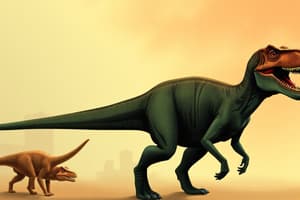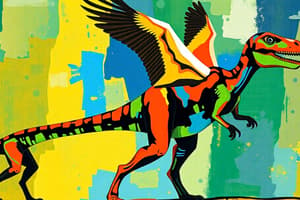Podcast
Questions and Answers
Which group of reptiles includes the lineage that leads to modern lizards and snakes?
Which group of reptiles includes the lineage that leads to modern lizards and snakes?
- Lepidosaurs (correct)
- Archosaurs
- Euryapsids
- Diapsids
What major evolutionary change is associated with archosaurs?
What major evolutionary change is associated with archosaurs?
- Changes to the ankle structure (correct)
- Increasing size of body armor
- Development of fully aquatic forms
- Formation of jaw structures
Which of the following is NOT a characteristic of diapsid reptiles?
Which of the following is NOT a characteristic of diapsid reptiles?
- Possession of adaptations for fully upright postures
- Development into the mammal-like reptiles (correct)
- Divisions into Lepidosaurs and Archosaurs
- Ankle adaptations leading to semi-upright postures
Which lineage under archosaurs includes pterosaurs and dinosaurs?
Which lineage under archosaurs includes pterosaurs and dinosaurs?
Which type of fish is considered a precursor to amphibians?
Which type of fish is considered a precursor to amphibians?
What group do lobe-finned fish belong to in the context of evolutionary steps leading to dinosaurs?
What group do lobe-finned fish belong to in the context of evolutionary steps leading to dinosaurs?
What significant evolutionary innovation allowed early reptiles to lay eggs on land?
What significant evolutionary innovation allowed early reptiles to lay eggs on land?
Which of the following is considered the first true vertebrate?
Which of the following is considered the first true vertebrate?
What feature distinguishes amphibians from earlier tetrapod ancestors?
What feature distinguishes amphibians from earlier tetrapod ancestors?
What characteristic do lobe-finned fish possess that is crucial for their adaptation to terrestrial environments?
What characteristic do lobe-finned fish possess that is crucial for their adaptation to terrestrial environments?
Which of the following statements about early reptiles is NOT true?
Which of the following statements about early reptiles is NOT true?
What was a key feature of transitional species like Tiktaalik?
What was a key feature of transitional species like Tiktaalik?
The earliest chordates, such as Pikaia, evolved during which geological period?
The earliest chordates, such as Pikaia, evolved during which geological period?
What is the meaning of the name Pteranodon longiceps?
What is the meaning of the name Pteranodon longiceps?
During which geological period did pterosaurs exist from the Late Triassic to the end of the Cretaceous?
During which geological period did pterosaurs exist from the Late Triassic to the end of the Cretaceous?
What adaptation is primarily associated with pterosaurs?
What adaptation is primarily associated with pterosaurs?
What is the estimated wingspan of Quetzalcoatlus, one of the largest pterosaurs?
What is the estimated wingspan of Quetzalcoatlus, one of the largest pterosaurs?
Which of the following is a key characteristic of pterosaur wings?
Which of the following is a key characteristic of pterosaur wings?
Which group is considered the sister clade to the dinosaurs?
Which group is considered the sister clade to the dinosaurs?
What is a characteristic feature of archosaurs distinct from other reptiles?
What is a characteristic feature of archosaurs distinct from other reptiles?
Which group includes both dinosaurs and birds?
Which group includes both dinosaurs and birds?
Within diapsids, which group represents reptiles with a fully upright posture?
Within diapsids, which group represents reptiles with a fully upright posture?
Which of the following is NOT a member of the Archosauria group?
Which of the following is NOT a member of the Archosauria group?
What does the term 'avemetatarsalia' refer to within the context of archosaur diversity?
What does the term 'avemetatarsalia' refer to within the context of archosaur diversity?
Which characteristic is shared by pterosaurs and dinosaurs?
Which characteristic is shared by pterosaurs and dinosaurs?
What group includes the largest dinosaurs and their relatives?
What group includes the largest dinosaurs and their relatives?
Flashcards are hidden until you start studying
Study Notes
Dinosaur Ancestry
- Tetrapods evolved from primitive fish, with the Cambrian period marking the appearance of early chordates like Pikaia (~510 million years ago).
- The first vertebrates were jawless fishes, followed by diversification into various fish types, including lobe-finned fish with both gills and lungs.
- Lobe-finned fish could "walk" on riverbeds and travel overland to access water, breathing through lungs.
Evolution of Tetrapods
- Amphibians were the first true tetrapods, exhibiting robust limb bones and represented by transitional species like Tiktaalik.
- Reptiles evolved from amphibians, showcasing adaptations such as skeletal modifications for life on land and the development of the amniotic egg, which allows eggs to be laid on land.
Tetrapod Family Tree
- Ancestral lineage includes: Pikaia, jawless fishes, placoderms, cartilaginous fishes, ray-finned fishes, lobe-finned fishes, amphibians, and reptiles.
- Reptile diversification includes various classes: anapsids, euryapsids, synapsids (leading to mammals), and diapsids.
Diapsid Reptiles
- Diapsids split into two main groups: Lepidosaurs (modern lizards and snakes) and Archosaurs (crocodilians and avemetatarsalia, which includes pterosaurs and dinosaurs).
- Archosaurs show key evolutionary innovations, particularly alterations to the ankle for different postures: semi-upright in pseudosuchia and fully upright in avemetatarsalia.
Pterosaurs
- Pterosaurs, known as "winged lizards," form a sister clade to dinosaurs and existed from the Late Triassic to the end of the Cretaceous (228-66 million years ago).
- Notable pterosaurs include Pteranodon longiceps, known for its wingspan of over 6 meters (20 feet) and its toothless, long-headed structure.
Azhdarchids
- Azhdarchids represent some of the largest pterosaurs. Notable examples include Quetzalcoatlus, with an impressive wingspan reaching 11 meters.
- Fossils suggest Quetzalcoatlus lived in North America around 85 million years ago.
Adaptations for Flight
- Pterosaur wings are constructed from a membrane of skin, tissues, and muscles, indicating significant adaptations for powered flight.
- Odd body dimensions in pterosaurs further complement their flight capabilities, showcasing evolutionary adaptations specific to their ecological niches.
Studying That Suits You
Use AI to generate personalized quizzes and flashcards to suit your learning preferences.




